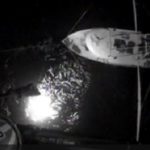Tag Archives: ADF&G
Pot Half Full: Cordova boats find success in Kodiak crab despite uncertainties
 As crab fisheries around the state become increasingly unstable over the last two years, fishermen have found reliable opportunities in Kodiak. Several Cordova vessels and captains journeyed to Kodiak this past month to participate in the 2024 Kodiak tanner crab fishery, a state fishery managed by the Alaska Department of Fish and Game (ADF&G). The fisheye opened at noon on Jan. 15 and closed on Jan. 21. This year Guideline Harvest Levels (GHL) allowed for 3,480,000 pounds of crab to be harvested by the fleet, down from the 7,300,000 pounds GHL in 2023. Last year the fleet staged a strike over the low grounds price of crab resulting in more than a week’s delay to the season. Although the price rose only marginally this season, the fleet went fishing on the regularly scheduled opener. Photos, more, >>click to read<< 14:37
As crab fisheries around the state become increasingly unstable over the last two years, fishermen have found reliable opportunities in Kodiak. Several Cordova vessels and captains journeyed to Kodiak this past month to participate in the 2024 Kodiak tanner crab fishery, a state fishery managed by the Alaska Department of Fish and Game (ADF&G). The fisheye opened at noon on Jan. 15 and closed on Jan. 21. This year Guideline Harvest Levels (GHL) allowed for 3,480,000 pounds of crab to be harvested by the fleet, down from the 7,300,000 pounds GHL in 2023. Last year the fleet staged a strike over the low grounds price of crab resulting in more than a week’s delay to the season. Although the price rose only marginally this season, the fleet went fishing on the regularly scheduled opener. Photos, more, >>click to read<< 14:37

Commercial crab fishery closed for 2023-2024 season
The Alaska Department of Fish and Game has closed the commercial red and blue king crab fishery for the 2023-2024 season, the sixth year in a row, citing stock survey numbers that remain well below the regulatory threshold. The announcement made Wednesday is a blow to commercial fishers, who saw a significant drop in prices for chum (dog) and pink (humpback) salmon this year. “If they would open up the crab season for 10-15 days it would help bail us out of a terrible season,” said Norval Nelson, owner and operator of Star of the Sea, which was in Aurora Harbor. He made his comments before he learned of the news. >>click to read<<17:27

PWS Seine fleet reacts to low prices
Halfway through the Prince William Sound seine season, captains and crew are reacting to a dramatic drop in pink and chum salmon prices. The price updates came in the form of official letters and informal text messages from various processors this week. Grounds price for pink salmon hovers at $.23/lb with chum salmon prices following at $.20/lb. Rumors of chum price dipping below $.20/lb were also reported by fishermen. The seine fleet has seen a season patterned by frequent closures this year. Jamel Lister is a seasonal deckhand who has returned to work in the fishery for his seventeenth year, this season aboard the F/V Gorbushka. Lister said although he does pay attention to salmon markets leading up to the season, a poor forecast or low price does not deter him from returning each summer. >click to read< 12:25

NOAA, ADFG, Bering Sea Crabbers Teaming Up On Red Crab Fishery Research
Tempestuous weather and icy seas make winter research on Bristol Bay red king crab challenging. This winter, crab fishermen are working together with scientists to make it possible. The Bering Sea crab industry is partnering with NOAA Fisheries’ Alaska Fisheries Science Center and the Alaska Department of Fish and Game to meet a critical need for winter data on Bristol Bay Red king crab. Scientists and fishermen will work together on the month-long field research, set to launch in March. The research responds directly to data requests from the North Pacific Fishery Management Council to inform their management decisions. Photos, >click to read< 10:12

Alaska snow crab harvest slashed by nearly 90% after population crash in a warming Bering Sea
The snow crab is a mainstay of the Alaska crab boat fleet, much of it based in Washington, and the 2021-22 catch limit of 5.6 million pounds, announced Friday, is down 88% from the previous season. The 2021 fall harvest of Bristol Bay red king crab, another important source of revenue for that fleet, was canceled for this year because of too few females. The combined impacts of the closure and snow crab cutbacks are a big financial hit to crabbers who in past years have grossed more than $200 million from the two harvests. At a meeting of the North Pacific Fishery Management Council this week, crabbers called for additional restrictions in other harvests. >click to read< 09:30

One Alaska Bay Is Booming With Salmon, For Now
Bristol Bay’s sockeye harvest has long made up about half of the global catch of this species, in a seasonal blitz as short as it is enormous: The fishery lasts a mere six weeks. Each summer, 15,000 seafood processors, boat-based fishermen, and setnetters, including families such as the Bandles, gather here to support an industry worth more than $2 billion in 2019. Some fishermen will net enough cash to live on until the fish come back the next year. And this year, Bristol Bay outdid itself,,, But such riches are localized. Outside of Bristol Bay, salmon fisheries are failing, including those on British Columbia’s famed Fraser River, on Alaska’s Chignik and Copper Rivers, and in Cook Inlet. Five hundred miles north of Bristol Bay, Yukon River salmon runs have totally collapsed. >click to read< 12:35 ADFG: Bristol Bay sockeye runs set all-time record – It’s official: Bristol Bay’s 2021 commercial salmon season was the largest on record. >click to read<
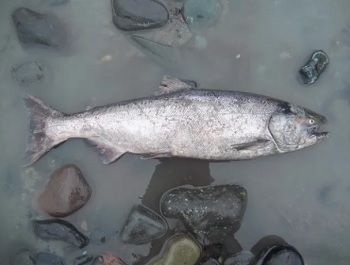
Tastes better
Every day it seems to become just a little more obvious that the future of the commercial salmon business is on land no matter what Alaskans might think about where the tastiest fish are to be found. This week the news is from northern Spain where a company named Norcantabric,,,On its website, the company boasts that its farm will produce salmon that are “fresh, reduces transport time up to 5 days; 100 percent natural, without antibiotics, free of toxins, heavy metals and other artificial materials, without hormones, without sea lice and free of parasites. There are long term implications here for an Alaska commercial fishing industry once the economic mainstay of the territory, and for decades after Statehood, the 49th state’s largest employer. >click to read< 16:50

Common property
Almost four decades ago, a Juneau salmon seiner by the name of Wayne Alex filed a lawsuit aimed at blocking the state of Alaska from taxing commercial fishermen to finance hatcheries. The tax, which the Alaska Legislature obliging called an “assessment” in an effort to avoid an Alaska Constitutional prohibition on dedicated taxes, was intended to benefit private, non-profit aquaculture corporations controlled by commercial fishermen. As the scheme was designed, the hatchery corporations, or “associations” as they were officially called, would run a system of hatcheries to fill the ocean off the 49th state with a bounty of “common property” salmon to benefit Alaskans of all sorts – commercial fishermen, personal-use fishermen, sport fishermen, even subsistence fishermen. Though Alex sued over the tax, it wasn’t his real concern. His fear was that the hatcheries would one day come to replace fishermen like himself. Jump ahead now 39 years and turn your attention north from Juneau for 550 miles to the city of Seward at the head of Resurrection Bay. >click to read< 16:01

Coronavirus: Observer plans modified for commercial crab season
Observer deployment plans for the upcoming commercial crab season have been modified by the Alaska Department of Fish and Game in order to reduce risks of exposure to the COVID-19 virus, while still meeting minimum stock assessment data needs. ADF&G officials said that to accommodate revised deployment strategies, all vessels initially placed on the alternate selection list should be advised that they have a higher likelihood of being selected to carry an observer. Additional details on final observer deployment plans are to be provided by ADF&G,,, >click to read< 07:39

ADF&G sockeye numbers questioned amid large pink salmon run
Joe Hanes has been on the river since 1969 and has operated a guide service on the river since 1986. He says he’s seen an apparent disconnect between the department’s numbers and the conditions in the river for around 15 years, especially on even-numbered years when Kenai sees a dramatically larger run of pink salmon. “A lot of people think they’re going to come down here and catch sockeye salmon because the department said over 300,000, or well over 200,000 sockeye came in the river the last few days,” Hanes said. “As we can see, they’re all pinks.” ADF&G Division of Commercial Fisheries operates theKenai Riverat river mile 19 of the Kenai River. >click to read< 11:19
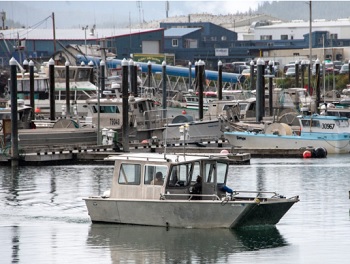
Prince William Sound harvest nears 19M salmon
Purse seine and drift gillnet harvests of salmon continue in earnest this week in Prince William Sound,,, The five year even year average for humpies through this date is 29 million fish. where the overall harvest has jumped from 11.2 million to 20.5 million salmon in a week, including some 17.6 million humpies. ADF&G’s Charlie Russell in Cordova said wild stocks of pinks this year have performed above average and will likely total some 6 million to 7 million fish, while hatcheries are likely this year to get about 50 percent of their forecast. PWS harvests of sockeye salmon rose from 902,000 a week ago to 924,000 on Aug. 12, while overall harvest totals for Chinook chum and coho salmon showed no significant growth. >click to read< 11:07

8 Day Southeast Trolling Shutdown to Start Friday
Southeast Alaska’s commercial troll salmon fishery will close for eight days, starting Thursday, due to low abundance of coho salmon, state Fish and Game officials announced today. The fishery will reopen August 15, they said. “The point of the closure is to try to move fish to the inside,” said ADFG Commercial Troll Management Biologist Grant Hagerman. “They’re not being exploited, they’re passing through the fishery… You’ve got this eight-day closure based on the below average (coho) catch rates and below average returns.” Hagerman said coho catches were low in all six trolling areas. >click to read< 10:07
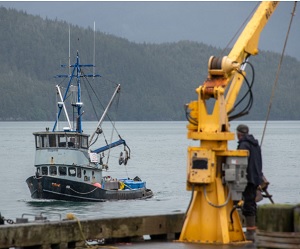
Copper River fishermen gain another harvest
Commercial harvesters keen on those Copper River salmon got a fifth shot at those prized Chinooks and reds on Thursday, June 18, in a 12-hour opener announced by Alaska Department of Fish and Game officials in Cordova. Waters within the expanded Chinook salmon inside closure area were closed for the period. It has been, in no uncertain terms a real slow start, with several of those openers already cancelled because of a very slow run. Through Tuesday, June 16, a total of 1,665 deliveries to processors from four 12-hour openers in the Copper River had brought in some 5,751 kings, 71,370 sockeyes and 1,056 chums, a total of 78,177 fish. >click to read< 16:01

Feb. 14 deadline for bids on Tanner crab test fishery
State fisheries officials have set a Feb. 14 deadline for bids to participate in a Prince William Sound test fishery from Feb. 22 through April 7, to harvest up to 30,000 pounds of Tanner crab. Six lots of up to 5,000 pounds each are available in defined areas of the Northern and Hinchinbrook districts, Bids will be accepted for six individual lots for a maximum of 5,000 pounds each, at a minimum bid price of 35 cents a pound, with the contract to be awarded to the highest bidders for each lot. Vessel owners are welcome to bid on more than one lot. >click to read< 16:38

Rockfish closure another blow to Southeast fleet
Southeast Alaska fishermen won’t get to target yelloweye rockfish in 2020, and that’s another notch in tightening belt for the area fleet. The Alaska Department of Fish and Game announced the full-year closure on Dec. 31, spanning both the commercial and recreational sectors. Targeted fishing for all nonpelagic rockfish, which includes species like yelloweye, quillback, tiger and china rockfish, will be closed across the region due to declining populations of the fish. >click to read< 11:00

Pink salmon disaster relief payments delayed
Federal relief payments to permit holders who participated in the disastrous 2016 Gulf of Alaska pink salmon fishery have hit another snag, and now won’t be forthcoming until March. News of the payment delay, which was slated to be within six to eight weeks of the Oct. 31 deadline for skipper applications for relief reached Rep. Louise Stutes, R-Kodiak, on Nov. 15. >click to read< 17:14

Prince William Sound season’s catch nears 56 million fish, statewide harvest now tops 201 million salmon
Statewide preliminary data compiled by ADF&G showed an overall harvest of 201 million fish, including 124.8 million pink, 55.3 million sockeye, 17.3 million chum, 3.4 million coho and 273,000 Chinook salmon. With the addition of some 100,000 fish last week, the 2019 Alaska commercial salmon season is nearly complete, noted Garrett Evridge of the McDowell Group, who compiles weekly commercial salmon reports in season on behalf of the Alaska Seafood Marketing Institute. >click to read< 10:47

Preliminary summary gives Bristol Bay highest exvessel value ever
After reviewing preliminary data from the season, Alaska Department of Fish & Game says that 2019 appears to be have produced the highest exvessel value of all time at $306.5 million. That means the money paid to boat captains as they unloaded their catches at dock was the highest ever, though the numbers don’t include adjustments for icing, bleeding, or production bonuses. The ADF&G summary also shows that the sockeye fun of 56.5 million >click to read< 10:46

Sockeye harvest breaks all-time top 5; pinks picking up
The 2019 salmon season has seen plenty of fish return to the state, but far from evenly across regions. As of Sept. 10, commercial fishermen across Alaska have landed 198.4 million salmon of all five species, about 8 percent less than the preseason forecast of 213.2 million. Most of that shortfall is in pink and chum salmon, which haven’t delivered on their forecasts so far, but a surplus of sockeye salmon helped make up for some of that gap. Statewide, commercial fishermen have landed more than 55.1 million sockeye, about 9 percent more than last year and 5 million more than the preseason forecast. >click to read< 07:40

Bristol Bay – Why the two main forecasts have a 5 million-fish difference
This year, 44.6 million sockeye salmon will return to Bristol Bay – if you trust the University of Washington forecast. But the University of Washington forecast isn’t the only one out there. “This year’s forecast is 40.18 million,” said Gregory Buck, Fish and Game’s fishery biologist and regional research coordinator for Bristol Bay. Buck says the almost 5 million sockeye difference between the ADF&G and UW forecasts has a pretty simple explanation: an accumulation of small data interpretation differences. >click to read< 10:31
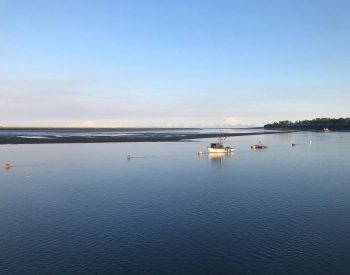
Cook Inlet fishermen celebrate ‘Return of the Reds’ with hope for 2019
Cook Inlet fishermen are looking forward to their salmon season with high hopes that the sockeye will arrive in better numbers than last year. On June 11, fishermen and processors grilled up some of the first Cook Inlet salmon of the year at the Pacific Star processing plant in Kenai, gathering to build excitement for the coming season. The plant is now receiving salmon from the west side of Cook Inlet, while the fishermen in the drift gillnet and east side set gillnet fleets gear up for their first expected openings in the coming weeks. >click to read<15:24

Copper River harvest hits 429,630 fish and rising
That sixth opener was the charm, “a very welcome relief for this fleet,” said drift gillnet harvester John Renner. “It appears to be a larger run than predicted,” said Renner, in a phone call from his Cordova home on Wednesday, June 5, in the wake of the 36-hour opener of the 2019 Copper River commercial salmon season, which ended at 7 p.m. the previous evening. “The fish are also large and healthy, indicating a larger component of older fish,” Renner said. “They are spread out across the flats offshore and onshore. “ >click to read<10:56

Seiners explain decision to stop test fishing
As of Tuesday evening, herring seiners in Sitka were standing down from further test fishing — but they weren’t calling it a strike.,,, Commercial fisherman Matt Kinney of Sitka has been involved with the sac roe herring fishery for the past 10 years and he says each year it’s exciting to take it all in. “It’s a big biomass out there that supports a lot of life whether it be sea lions or eagles or whales, but it’s pretty impressive to see on a grand scale.” So far this year, the Alaska Department of Fish and Game has found a lot of fish,,, >click to read<17:06

Seawatch: Board of Fish meets March 9
The Alaska Board of Fisheries kicks off its meeting dealing with state-wide finfish proposals on March 9 in Anchorage, covering about 20 proposals and expected to last four days. Those proposals include some that, while generalized to fit the criteria of a state-wide proposal, are clearly aimed at the relentless “fish wars” in the Upper Cook Inlet salmon fisheries. One of the proposals, submitted by the Kenai River Sportfishing Association,,, >click to read<17:06
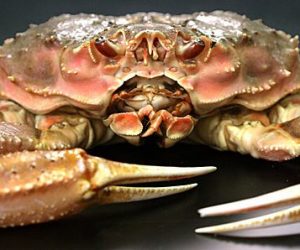
Southeast Alaska Tanner Crab Fishery Deadline Nears
The 2018/2019 commercial Tanner crab fishery in Southeast Alaska will open concurrently with the commercial golden king crab fishery on Feb. 12, 2019. The registration deadline is Jan. 14, and all commercial fishermen registering after the deadline will have to pay a $45 late fee. Permit holders may register at Alaska Department of Fish and Game area offices in Douglas, Sitka, Ketchikan, Petersburg, Wrangell and Haines. Simultaneous, though separate, registrations are allowed for Tanner crab and golden king crab. Commercial shrimp or Dungeness crab pot registrations may also be obtained and fished simultaneously with Tanner Crab,,, >click to read<06:58

Work continues on federal plan for Cook Inlet salmon
More than two years after a court ruling ordered the North Pacific Fishery Management Council to develop a management plan for the Cook Inlet salmon fishery, a stakeholder group has made a first set of recommendations. The council convened a Cook Inlet Salmon Committee last year composed of five stakeholders to meet and offer recommendations before the council officially amends the Fishery Management Plan, or FMP, for the drift gillnet salmon fishery in Upper Cook Inlet, which occurs partially in federal waters. >click to read<15:13
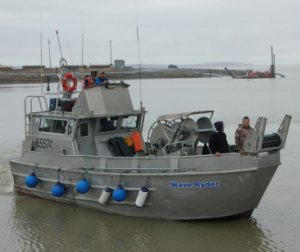
2019 Togiak herring forecast signals stable population, says ADF&G
The Togiak Pacific herring fishery will see a large return this spring, according to the recently released Alaska Department of Fish and Game 2019 forecast. Based on aerial surveys and population age, ADF&G predicts the Togiak District Pacific herring biomass will be 217,548 tons. That is a 59 percent increase from last year’s forecast. It will allow for a total harvest in the Togiak District sac roe herring fishery of 26,930 tons. “We feel confident we have a stable population there,” said Tim Sands, area management biologist. >click to read<15:58

It’s Official! 62.3 million: Bristol Bay’s 2018 salmon season the largest ever
It is official; 2018 was the largest sockeye salmon run to Bristol Bay on record, and the Alaska Department of Fish and Game has records dating back to 1893. The 2018 Bristol Bay Season Summary, which ADF&G released in September, reiterates the records this year’s run broke. To start with, the total run to Bristol Bay this summer was 62.3 million sockeye. That is 21 percent above the preseason forecast of 51.3 million fish.,, The ex-vessel value also broke a record – $281 million for all salmon species. >click to read<15:02

Bristol Bay salmon pay day is biggest on record on largest sockeye run since 1893
It’s a record breaking pay day for salmon fishermen at Bristol Bay, topping $280 million at the docks. That’s 242 percent above the 20 year average – and the number will go higher when bonuses and post season adjustments are added in. Bay fishermen averaged just under $215 million at the docks last year. According to a summary by the Alaska Dept. of Fish and Game, the 2018 sockeye salmon run Bristol Bay of 62.3 million fish was the biggest since 1893, and nearly 70 percent above the 20 year average. It also was the fourth consecutive year that sockeye runs topped 50 million fish. Audio report, >click to read<16:30

UPDATE: Fuel from sunken vessel closes fishing in Nushagak District
The Alaska Department of Fish and Game announced the closure of the Nushagak District to all commercial fishing as of 1:00 p.m. Thursday after fuel from the sunken fishing vessel Pacific Knight was observed by air. According to ADF&G, fuel was seen by Fish and Game staff pooling in tide rips. The sheen is expected to spread across Nushagak Bay toward Dillingham with the tide, and presents a “significant chance of gear and fish being exposed to fuel.” The department also warns of the chance for gear and fish to be contaminated on Dillingham’s beaches. ADF&G says staff will continue to monitor the spread of fuel. There is no immediate timetable for when fishing might reopen. >click to read<20:41







































